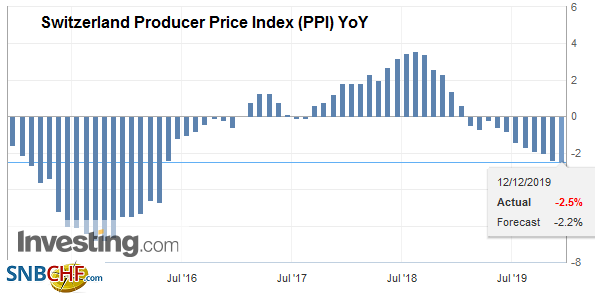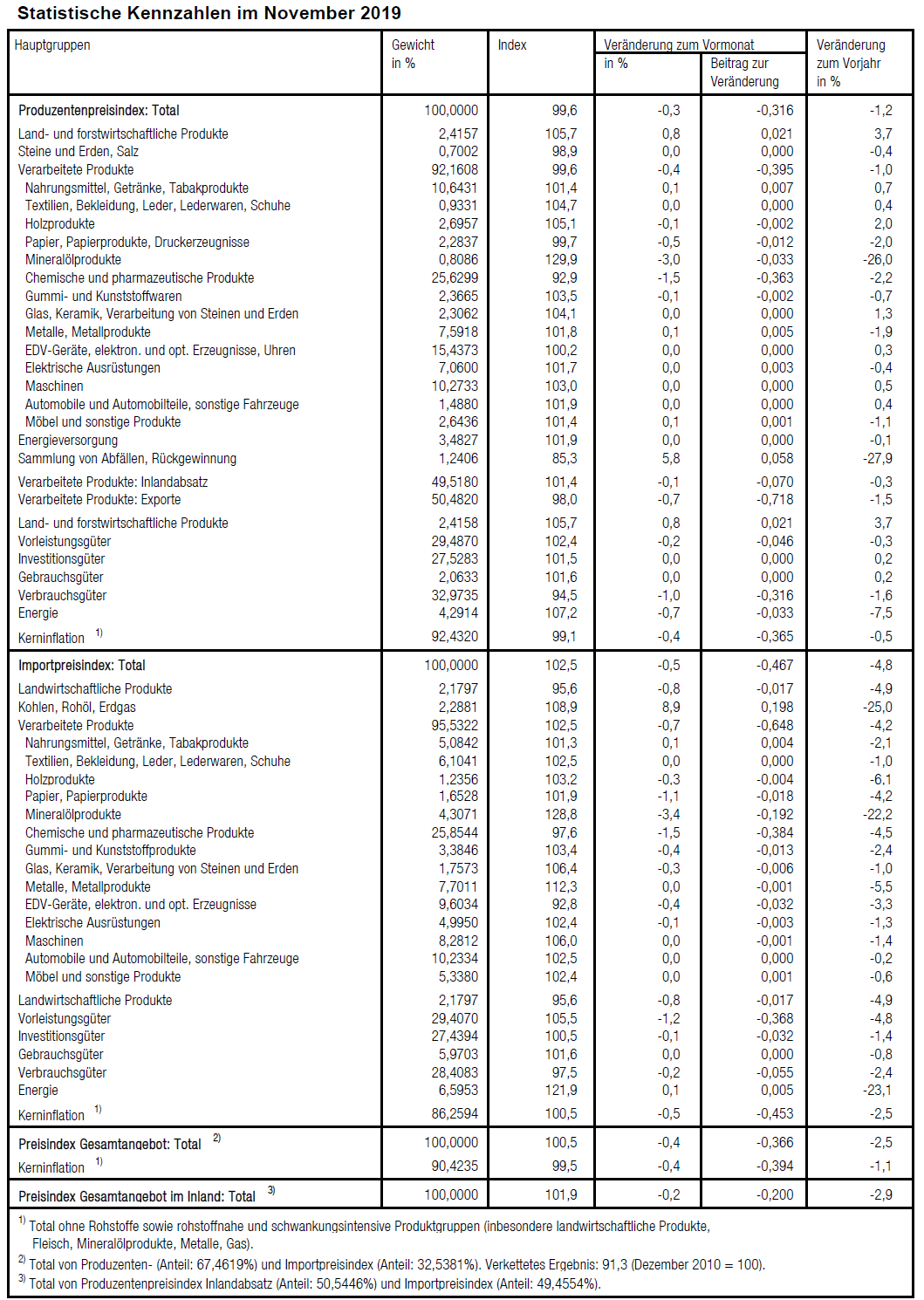The Producer Price Index (PPI) or officially named “Producer and Import Price Index” describes the changes in prices for producers and importers. For us it is interesting because it is used in the formula for the Real Effective Exchange Rate. When producers and importers profit on lower price changes when compared to other countries, then the Swiss Franc reduces its overvaluation. The Swiss PPI values of -6% in 2015 (see below), compared to -3% in Europe or -1% in the U.S., diminished the overvaluation. In 2017, however, producer prices are rising again – in both Europe and Switzerland. See more in Is the Swiss Franc overvalued? 12.12.2019 – The Producer and Import Price Index fell in November 2019 by 0.4% compared with the previous month, reaching 100.5 points
Topics:
George Dorgan considers the following as important: 2.) Swiss Statistics - Press Releases, 2) Swiss and European Macro, Featured, newsletter, Switzerland Producer Price Index
This could be interesting, too:
Nachrichten Ticker - www.finanzen.ch writes Die Performance der Kryptowährungen in KW 9: Das hat sich bei Bitcoin, Ether & Co. getan
Nachrichten Ticker - www.finanzen.ch writes Wer verbirgt sich hinter der Ethereum-Technologie?
Martin Hartmann writes Eine Analyse nach den Lehren von Milton Friedman
Marc Chandler writes March 2025 Monthly
The Producer Price Index (PPI) or officially named “Producer and Import Price Index” describes the changes in prices for producers and importers. For us it is interesting because it is used in the formula for the Real Effective Exchange Rate. When producers and importers profit on lower price changes when compared to other countries, then the Swiss Franc reduces its overvaluation. The Swiss PPI values of -6% in 2015 (see below), compared to -3% in Europe or -1% in the U.S., diminished the overvaluation. In 2017, however, producer prices are rising again – in both Europe and Switzerland. See more in Is the Swiss Franc overvalued?
| 12.12.2019 – The Producer and Import Price Index fell in November 2019 by 0.4% compared with the previous month, reaching 100.5 points (December 2015 = 100). This decline was due in particular to lower prices for chemical and pharmaceutical products. Compared with November 2018, the price level of the whole range of domestic and imported products fell by 2.5%. These are some of the findings from the Federal Statistical Office (FSO). |
Switzerland Producer Price Index (PPI) YoY, November 2019(see more posts on Switzerland Producer Price Index, ) Source: investing.com - Click to enlarge |
Download press release: Producer and Import Price Index fell by 0.4% in November 2019
German Text:
Produzenten- und Importpreisindex sinkt im November 2019 um 0,4%12.12.2019 – Der Gesamtindex der Produzenten- und Importpreise sank im November 2019 gegenüber dem Vormonat um 0,4% und erreichte den Stand von 100,5 Punkten (Dezember 2015 = 100). Der Rückgang ist vor allem auf tiefere Preise für chemische und pharmazeutische Produkte zurückzuführen. Im Vergleich zum November 2018 ging das Preisniveau des Gesamtangebots von Inland- und Importprodukten um 2,5% zurück. Dies geht aus den Zahlen des Bundesamts für Statistik (BFS) hervor. Für den Rückgang des Produzentenpreisindexes gegenüber dem Vormonat waren vor allem die tieferen Preise für pharmazeutische Spezialitäten verantwortlich. Billiger wurden auch chemische Grundstoffe, Mineralölprodukte und pharmazeutische Grundstoffe. Steigende Preise beobachtete man dagegen für Schrott und Rohmilch. Tiefere Preise gegenüber dem Oktober 2019 registrierte man im Importpreisindex insbesondere für chemische Produkte und Mineralölprodukte. Preisrückgänge zeigten auch pharmazeutische Grundstoffe, Computer und Zitrusfrüchte. Preiserhöhungen beobachtete man hingegen vor allem für Erdöl und Erdgas. Teurer wurden auch Nichteisen-Metalle und daraus hergestellte Produkte. |
 . |
Statistische Kennzahlen im November 2019
Tags: Featured,newsletter,Switzerland Producer Price Index

